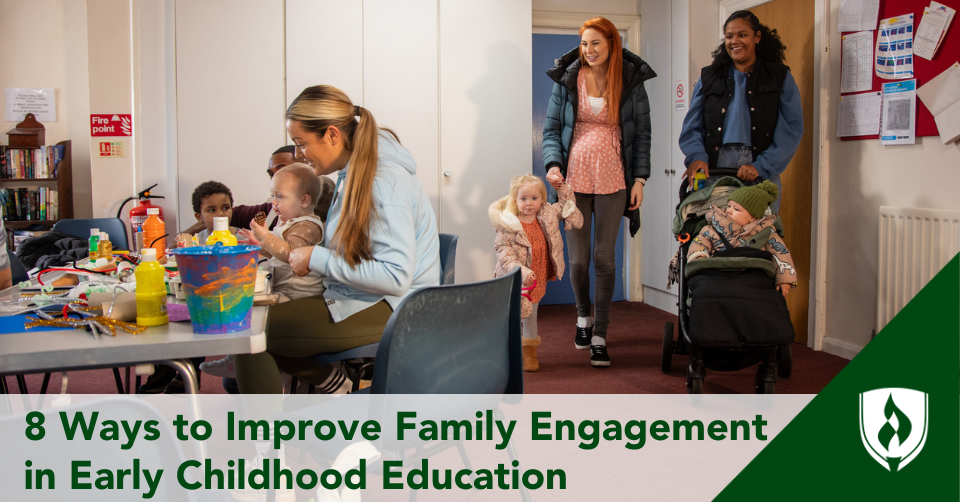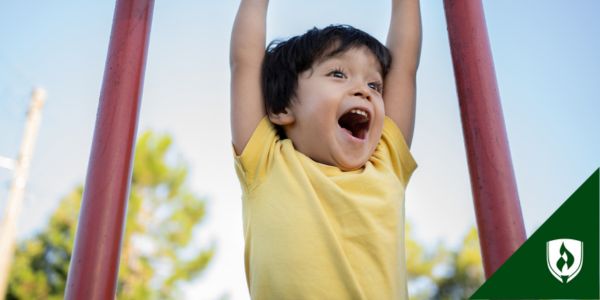
Early childhood education (ECE) isn’t just your dream job. It’s your calling. And you can’t imagine a better life than one spent working with young children.
If ECE were only about those kiddos, you’d be golden. But so much of early childhood education is about including their families and loved ones.
And sometimes, maintaining relationships with parents and guardians is challenging. Coordinating with children’s families may even start to feel a bit like having a second job. But, as any ECE director will tell you, family involvement is paramount to your success—and the children’s.
What is family engagement in early childhood education?
Family engagement in early education refers to a collaborative process between classroom teachers and their students’ parents, guardians or caretakers. Effective family engagement aligns classroom activities and objectives with families’ own goals and priorities for their children, increasing family satisfaction with your program.
“When you’re interacting with the families in your program, it has to be more than just, ‘This is how we do things in our program.’ It’s more of a, ‘We do this in our program; how does that fit within your family?’” says Dr. Mary Muhs, Associate Dean of Education at Rasmussen University and author of Family Engagement in Early Childhood Settings Quick Guide.
Oftentimes, early childhood education providers are the first non-family adults in a child’s life. So, not only are the children themselves typically unsure of what to expect while they’re in your care—their parents and are often in the same spot. Especially first-time parents and caregivers.
But, the more you prioritize family engagement, the more confident your program’s children and families (and you) will become along the way.
“Children perform better in the classroom when the families are involved,” says Deidra Boodoo, ECE Professor at Rasmussen University.
“The educator can build a better relationship with the families when they are involved in the center, and the school begins to feel more like home to the child if the families are visible at the early education site,” she adds.
8 tips for engaging families in early childhood education
1. Demonstrate professionalism
Parents and families are trusting you with their most precious gifts: their babies. They need—and deserve—to know they’ve made the right decision by enrolling in your program.
Try to think of each interaction with parents and guardians as a chance to show them that their children are in good hands.
“Be prepared when meeting with families,” Boodoo says. “If you have a meeting with a family member, be on time, review the information, have all your information ready and up-to-date to share with the families.”
It may sound simple, but those impressions go a long way!
2. Establish a partnership early on
“When you first meet a family, set up some time to talk about their child,” Muhs says. “The relationship that you build from that moment will set the stage for everything else going forward.”
It’s a lose-lose situation for everyone when family participation in early childhood involves teachers and guardians butting heads. All parties need to work toward shared child development goals. And these goal-oriented relationships begin from the very first moment a classroom teacher or ECE program director is introduced to a new family.
Establish as much trust as you can right from the start.
“Your first meeting will set the stage for when you have a challenging conversation to have with them, and you might have to bring up something sensitive,” Muhs says. “You’ll have already established a relationship, and you’ll know how they’re going to react.”
3. Share your expertise with families
Most families are experts on their own children, but they may not be experts in early childhood education. It’s normal for families to have difficulties navigating their children’s development, simply because there’s a lot to deal with.
Present yourself as a resource. One way to do this is to share insight and advice for corrective actions when you’re faced with telling families about poor behavior.
“When a situation comes up, like biting, the educator should be ready to let the family know that this is normal for the child’s age,” says Boodoo. Caregivers might feel shame, surprise or worry that there’s something wrong with their child. And they might be totally at a loss for how to change the behavior.
Use your knowledge of child development to reassure them and empower them, Boodoo advises.
“It is important for educators to know child development, so when there is a problem, or the families have unrealistic expectations, the educator can fall back on child development to educate the families,” Boodoo says. Since child development involves understanding how our brains grow, you can rely on the information to navigate differences without dismissing the family’s culture or preferences.
4. Know when to defer to the family
One common mistake teachers make is pushing too hard against what a family wants.
It’s true, your background, education and career have all equipped you with a solid understanding of young children’s developmental needs. And, when the situation calls for it, sharing your expertise with families can benefit everyone.
Still, there will inevitably be times when a parent or guardian has considered your professional input and decides against your recommendations. As frustrating as that may be for you, arguing with a child’s family will only prove counterproductive.
“Parents are the number one teacher…They’re the child’s most important teacher in their lives. We are secondary,” says Muhs.
“Sometimes, we get so involved with the family or the child, or we get so connected to a child, that, inadvertently, we kind of take on the idea that we know what’s best for this child. And, although we may have some ideas, and we’ve got the educational background that might give us some support, it’s not our decision.”
You want your students’ families to all feel supported when they talk to you. So, when disagreements arise and families disregard your advice, let them know you’re still happy to provide guidance along the way.
5. Always be friendly
This one may seem obvious, but it’s also easy to overlook. Working with children—especially young children and toddlers—can wear out the nerves of even the most Zen, relaxed people. But, no matter how exhausted, frustrated or frazzled you feel during your workday, it’s important to put on a friendly face and treat family members with warm encouragement.
“Just smiling is rule number one,” Muhs says. “Look like you’re happy to be there, even if the day was very stressful for you. Parents want to know [their children are] in the care of somebody who is pleasant and happy and not stressed.”
This is part of professionalism in ECE as well. When the families see an attentive, smiling teacher who greets them and honors their concerns, it’s easy for them to see you doing the same with their beloved child. Even if it feels hard to keep a smile on your face after an exhausting day, remaining friendly will make your work easier in the long run.
6. Compliment parents and families on what they do well
Family engagement involves building relationships. It’s easy for caregivers to feel judged or found wanting when it comes to parenting.
Counter that tendency by encouraging families to continue doing what they do well.
“Let parents know that you think they’re doing a good job, even for the tiniest things that they’re doing well,” says Muhs. “They get their child to childcare every single day. Their child is clean, dressed, comes in with a skip in their step and is happy to be there. Fantastic. That’s an accomplishment.”
Remember that families are typically going through a great deal behind the scenes. “They’re doing great as a parent,” Muhs says. “Helping them see that they’re doing well with their kids is part of building that relationship.”
7. Share classroom victories, big and small
Every family wants to see their child achieve success in school. From building social skills to learning the alphabet, each new achievement throughout a child’s education gives their family something to celebrate.
Aside from pursuing academic success, families also want reassurance that you are giving their child individualized attention. And they won’t know about all the observation and nurturing you’re doing unless you share with them.
Early education providers should make a point of letting families know about the meaningful ways in which they’re interacting with each child. Maybe that’s telling parents about a new favorite song kids learned in the classroom and sharing the lyrics so families can sing together when they’re at home, as Muhs suggests.
“[It] takes a lot of pressure off of a parent to know that you’ve made a connection with their child,” she adds.
This may take a conscious effort, especially if family engagement doesn’t come naturally to you. But, remember, families don’t get to see everything that happens in the classroom. Things like sing-alongs and story times that may seem everyday to you are exciting, new adventures parents want to hear about.
“Families get the idea educators are just providing care, but not education, to their children,” says Boodoo. “Providing the families with information on knowledge gained in the day, along with care given throughout the day, will help families to see that early educators do more than just provide care to the children,” she adds.
And, while the point of sharing this information isn’t completely self-serving, the fact remains that keeping parents informed of their children’s progress will give them a greater appreciation for all your hard work. Grab some of that shine!
8. Take an interest in families’ routines and habits
One of the best ways you can encourage families—and positive outcomes—in your classroom is by creating a learning environment that complements the children’s unique home lives.
This helps lessen the blow of “culture shock” children may feel when acclimating to a school routine.
Boodoo suggests considering the child’s home life and implementing similarities when possible. “Parents will feel more comfortable when the child’s care routine is adhered to, which, in turn, can strengthen the relationship with the families, creating harmony in the classroom.”
Muhs recommends asking families about their routines during your first interactions with them. Her advice is to ask plenty of questions about the child and find out exactly what a normal day in their life looks like.
“[Say], ‘Tell me about your child. Tell me about a typical Saturday morning at your house. What is a bedtime routine that you have? Tell me what you enjoy most about your child.’ Ask questions to really get to know their child, but really, to also know their parenting,” Muhs says.
Try to learn how they parent and what they’re worried about. “That will really set the stage for them,” Muhs says.
Working to help families feel connected to you builds strong relationships that serve as a foundation for the children’s learning and your own success in your ECE career.
Ready to explore new heights in ECE?1
Family engagement research represents a critical component of Rasmussen’s Child Development Associate® (CDA) program.2
Students also discover strategies for creating successful early childhood systems to support children from diverse backgrounds in achieving their educational and developmental goals.
Interested in learning more? Check out our articles, “Is Earning a Child Development Associate Credential Worth It?” and "Early Childhood Mental Health: 8 Things ECE Professionals Should Know".
Child Development Associate and CDA are registered trademarks of the Council for Professional Recognition
1The Early Childhood Education programs at Rasmussen University are not designed to meet, and do not meet, the educational requirements for licensure to teach in public preschools, or kindergarten, elementary , or secondary schools in any state. The Rasmussen University Early Childhood Education programs are not approved by any state agency that licenses teachers. Before enrolling, it is important to understand all of the licensure eligibility standards for a desired career by consulting the appropriate state and school/facility requirements.
2Rasmussen University’s Early Childhood Certificate program contains the following courses, which provide the educational prerequisites for the CDA® credential: EEC1202, EEC1700, EEC1735. Additional CDA® Credential eligibility requirements apply. Please consult the CDA eligibility requirements of the Council for Professional Recognition for further details.




